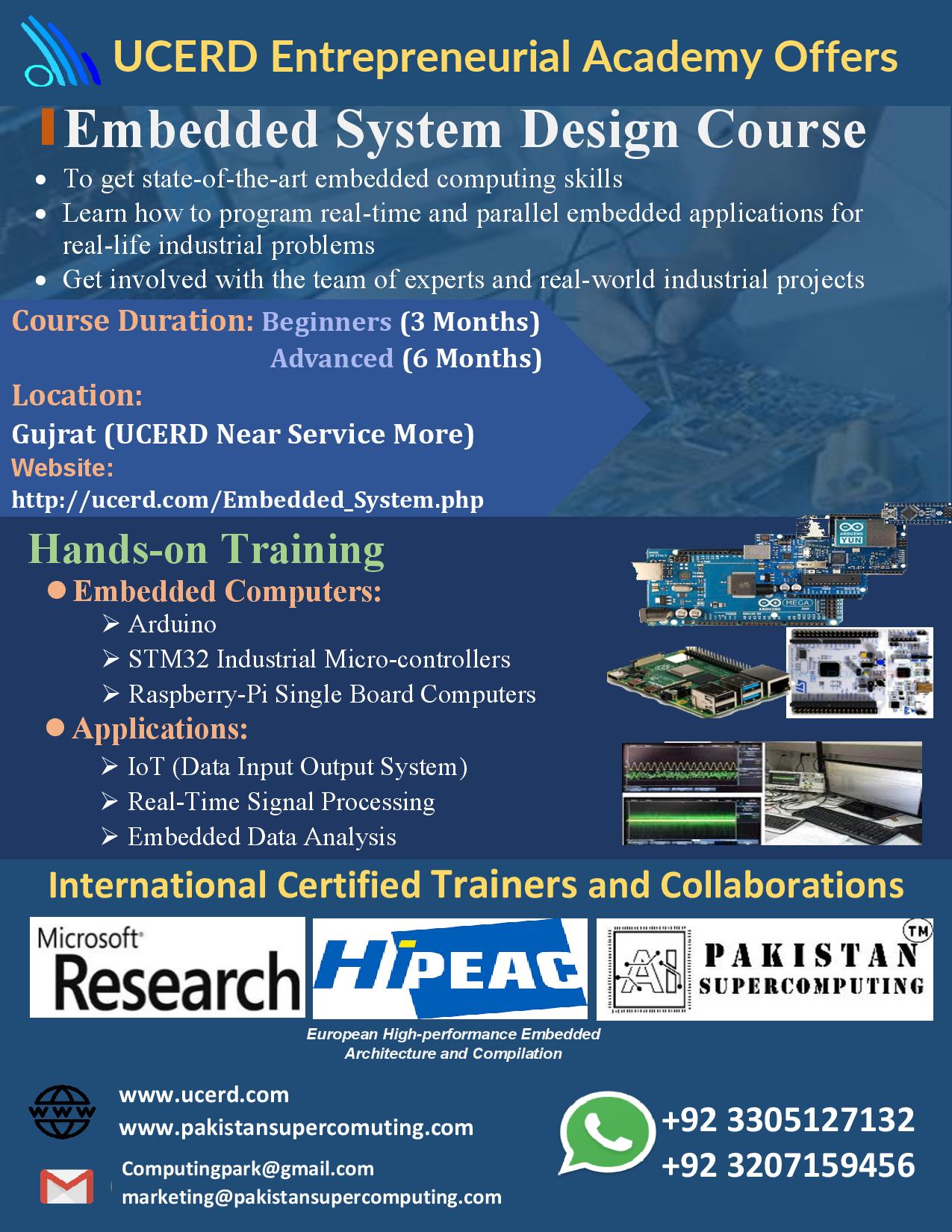Introduction to Embedded Systems and Applications
Fundamental of Embedded Computer Systems (2.1 Slides)
Classes of Computers
Defining Computer Architecture
Multi-core Embedded System Platforms
Processors
Low Power Low Cost and High Performance Processor Architectures
Buses and Peripherals
Address Mapping
Memory Mapping
Processor Interfacing
Memory Hierarchy
Shared Memory Architecture
Classification of Shared Memory Systems
Bus-Based Symmetric Multiprocessors
Basic Cache Coherency Methods
Snooping Protocols
Multiprocessors Bus Interconnection Networks
Softwares
System Softwares
User Softwares
STM32CubeIDE ( Tutorial LED Blinking STM32Discovery )
Numbers Systems (Real and Floating Point)
Real-time and Non Real-time Systems and Applications
Software Programming Environment
Machine Language
Assembly Language
C/C++ Programming Languages
Python Scripting Language
Artificial Intelligence Frameworks
Executing Real-world Problem on Embedded Multi-core System Architecture
Biomedical Sensor Interfacing and Signal Processing
Examples:
Blinky: This simple example simply blinks the board LED's. blinky.tar.gz
Serial: This example shows you how to use the UART. serial.tar.gz
PWM: This example generates 4 different PWM signals pwm.tar.gz
Accelerometer: This example interfaces to the acceleromter/compass and sends data back over a serial link. accelerometer.tar.gz
Gyro: This example interfaces to the gyroscope and sends data back over a serial link. gyro.tar.gz
Fundamental of Embedded Computer Systems (2.1 Slides)
Classes of Computers
Defining Computer Architecture
Multi-core Embedded System Platforms
Processors
Low Power Low Cost and High Performance Processor Architectures
Buses and Peripherals
Address Mapping
Memory Mapping
Processor Interfacing
Memory Hierarchy
Shared Memory Architecture
Classification of Shared Memory Systems
Bus-Based Symmetric Multiprocessors
Basic Cache Coherency Methods
Snooping Protocols
Multiprocessors Bus Interconnection Networks
Softwares
System Softwares
User Softwares
STM32CubeIDE ( Tutorial LED Blinking STM32Discovery )
Numbers Systems (Real and Floating Point)
Real-time and Non Real-time Systems and Applications
Software Programming Environment
Machine Language
Assembly Language
C/C++ Programming Languages
Python Scripting Language
Artificial Intelligence Frameworks
Executing Real-world Problem on Embedded Multi-core System Architecture
Biomedical Sensor Interfacing and Signal Processing
Examples:
Blinky: This simple example simply blinks the board LED's. blinky.tar.gz
Serial: This example shows you how to use the UART. serial.tar.gz
PWM: This example generates 4 different PWM signals pwm.tar.gz
Accelerometer: This example interfaces to the acceleromter/compass and sends data back over a serial link. accelerometer.tar.gz
Gyro: This example interfaces to the gyroscope and sends data back over a serial link. gyro.tar.gz
Labs and Hands on Work
Introduction to STM32
Settingup Software (Kiel)
Programming GPIOs
1. Overview of ARM Cortex-M General Purpose InputOutput Module
2. Coding Developing GPIO Driver Using Information from the Datasheet
3. Coding Controlling GPIO using the BSRR Register
4. Coding Reading GPIO Inputs
Configuring UART (Serial Communication)
1. Overview of the UART Protocol
2. Coding Developing the UART Driver Using Information from the Datasheet
3. Coding Receiving Data with the UART
4. Coding Two-way UART Communication
Introduction to STM32
Settingup Software (Kiel)
Programming GPIOs
1. Overview of ARM Cortex-M General Purpose InputOutput Module
2. Coding Developing GPIO Driver Using Information from the Datasheet
3. Coding Controlling GPIO using the BSRR Register
4. Coding Reading GPIO Inputs
Configuring UART (Serial Communication)
1. Overview of the UART Protocol
2. Coding Developing the UART Driver Using Information from the Datasheet
3. Coding Receiving Data with the UART
4. Coding Two-way UART Communication
1. The RISC Design Philosohpy
2. ARM Design Philosophy
3.Embedded_Systems_with_ARM_Processors.zip
4.Bus System
5.Memory
6. Peripherals
7. Von Nuemann and Harvard architecture
8. Cache and Tightly Couple Memory
9. Memory Management extensions
10. Cooprocessor extensions.zip
Basic of ARM Processoring :
1. Data Types
2. Processor Modes
3. ARM7TDMI Registers
4. ARM7TDMI Vector Table
5. ARM Cortex-M Registers
6. ARM Cortex-M Vector Table
7. ARM Data Flow Model
8. The Pipeline
9. ARM Processor Family
10. ARM Cortex-A and Cortex-R
2. ARM Design Philosophy
3.Embedded_Systems_with_ARM_Processors.zip
4.Bus System
5.Memory
6. Peripherals
7. Von Nuemann and Harvard architecture
8. Cache and Tightly Couple Memory
9. Memory Management extensions
10. Cooprocessor extensions.zip
Basic of ARM Processoring :
1. Data Types
2. Processor Modes
3. ARM7TDMI Registers
4. ARM7TDMI Vector Table
5. ARM Cortex-M Registers
6. ARM Cortex-M Vector Table
7. ARM Data Flow Model
8. The Pipeline
9. ARM Processor Family
10. ARM Cortex-A and Cortex-R
Mastering STM32
Programming with STM32: Getting Started with the Nucleo Board and C/C++
Embedded systems : ARM programming and optimization
Computers as Components: Principles of Embedded Computing System Design
ARM Assembly Language: Programming and Architecture
ARM system-on-chip architecture
ARM ISA
Real-Time Embedded Systems. By Jiacun Wang, Publisher:Wiley 2017.
Linux for Embedded and Real-time Applications, Fourth Edition Dec 15, 2017 by Doug Abbott
Dr. Tassadaq Hussain:
He is a permanent faculty member at, Riphah International University.
He did his Ph.D. from Barcelona-tech Spain, in collaboration with Barcelona Supercomputing Center and Microsoft Research Center.
He is a member of HiPEAC: European Network on High Performance and Embedded Architecture and Compilation, Barcelona Supercomputing Center and Microsoft ResearchCentre Spain.
Until January 2018, he had more than 14 years of industrial experience including, Barcelona Supercomputing Centre Spain, Infineon technology France, Microsoft Research Cambridge, PLDA Italia, IBM Zurich Switzerland, and REPSOL Spain. He has published more than 50 international publications and filed 5 patents.
Tassadaq's main research lines are Machine Learning, Parallel Programming, Heterogeneous Multi-core Architectures, Single board Computers, Embedded Computer Vision, Runtime Resource Aware Architectures, Software Defined Radio and Supercomputing for Artificial Intelligence and Scientific Computing.
www.tassadaq.ucerd.com
He is a permanent faculty member at, Riphah International University.
He did his Ph.D. from Barcelona-tech Spain, in collaboration with Barcelona Supercomputing Center and Microsoft Research Center.
He is a member of HiPEAC: European Network on High Performance and Embedded Architecture and Compilation, Barcelona Supercomputing Center and Microsoft ResearchCentre Spain.
Until January 2018, he had more than 14 years of industrial experience including, Barcelona Supercomputing Centre Spain, Infineon technology France, Microsoft Research Cambridge, PLDA Italia, IBM Zurich Switzerland, and REPSOL Spain. He has published more than 50 international publications and filed 5 patents.
Tassadaq's main research lines are Machine Learning, Parallel Programming, Heterogeneous Multi-core Architectures, Single board Computers, Embedded Computer Vision, Runtime Resource Aware Architectures, Software Defined Radio and Supercomputing for Artificial Intelligence and Scientific Computing.
www.tassadaq.ucerd.com
UCERD Rawalpindi
Supercomputing Center
UCERD Murree
Embedded System Design & Applications
Embedded Systems are computing systems designed for a particular application and embedded in a technical context, e.g. mobile phones, smart cards, vehicular electronics, consumer electronics devices, etc. The growing interest in the systematic design of such systems is inspired by the increase in variety and complexity of the applications.
Embedded Technology is now in its earliest, and the wealth of information accessible is mindblowing.
The shift towards multi-core computer architectures poses several challenges for computer architects. With each new technology generation, there will be a significant increase in the number of transistors. In this course, students will study how to establish processor structures that can transform the rise in transistors into an equal improvement in computational performance efficiency. The student will take start from learning basic architecture of single processor (core) to improve single-thread performance, via the design of the memory system, bus interconnect networks and will end at cluster architecture having multiple processor cores.
The course "Embedded Systems & Applications" covers computer system issues like Power wall, Memory Wall, and Programmability wall for biomedical signal processing applications. The course targets HW/SW architectures of “System-on-a-Chip (SoC) implementations. These SoC’s are composed of hardware and software components which must be seamlessly integrated together to produce working SOCs. These systems are becoming increasingly complex utilizing micro-architectural features from high performance computing platforms and from operating systems such as Linux.
Embedded Technology is now in its earliest, and the wealth of information accessible is mindblowing.
The shift towards multi-core computer architectures poses several challenges for computer architects. With each new technology generation, there will be a significant increase in the number of transistors. In this course, students will study how to establish processor structures that can transform the rise in transistors into an equal improvement in computational performance efficiency. The student will take start from learning basic architecture of single processor (core) to improve single-thread performance, via the design of the memory system, bus interconnect networks and will end at cluster architecture having multiple processor cores.
The course "Embedded Systems & Applications" covers computer system issues like Power wall, Memory Wall, and Programmability wall for biomedical signal processing applications. The course targets HW/SW architectures of “System-on-a-Chip (SoC) implementations. These SoC’s are composed of hardware and software components which must be seamlessly integrated together to produce working SOCs. These systems are becoming increasingly complex utilizing micro-architectural features from high performance computing platforms and from operating systems such as Linux.





